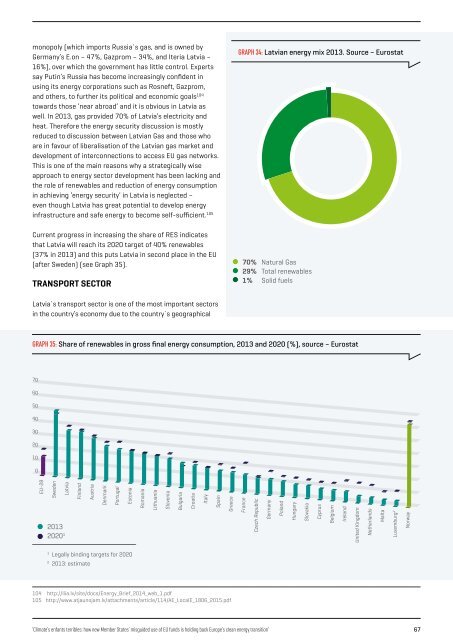ENFANTS TERRIBLES
enfants-terribles
enfants-terribles
Create successful ePaper yourself
Turn your PDF publications into a flip-book with our unique Google optimized e-Paper software.
monopoly (which imports Russia`s gas, and is owned by<br />
Germany’s E.on – 47%, Gazprom – 34%, and Iteria Latvia –<br />
16%), over which the government has little control. Experts<br />
say Putin’s Russia has become increasingly confident in<br />
using its energy corporations such as Rosneft, Gazprom,<br />
and others, to further its political and economic goals 104<br />
towards those ‘near abroad’ and it is obvious in Latvia as<br />
well. In 2013, gas provided 70% of Latvia’s electricity and<br />
heat. Therefore the energy security discussion is mostly<br />
reduced to discussion between Latvian Gas and those who<br />
are in favour of liberalisation of the Latvian gas market and<br />
development of interconnections to access EU gas networks.<br />
This is one of the main reasons why a strategically wise<br />
approach to energy sector development has been lacking and<br />
the role of renewables and reduction of energy consumption<br />
in achieving ‘energy security’ in Latvia is neglected –<br />
even though Latvia has great potential to develop energy<br />
infrastructure and safe energy to become self-sufficient. 105<br />
GRAPH 34: Latvian energy mix 2013. Source – Eurostat<br />
Current progress in increasing the share of RES indicates<br />
that Latvia will reach its 2020 target of 40% renewables<br />
(37% in 2013) and this puts Latvia in second place in the EU<br />
(after Sweden) (see Graph 35).<br />
TRANSPORT SECTOR<br />
70% Natural Gas<br />
29% Total renewables<br />
1% Solid fuels<br />
Latvia`s transport sector is one of the most important sectors<br />
in the country’s economy due to the country`s geographical<br />
GRAPH 35: Share of renewables in gross final energy consumption, 2013 and 2020 (%), source – Eurostat<br />
70<br />
60<br />
50<br />
40<br />
30<br />
20<br />
10<br />
0<br />
EU-28<br />
Sweden<br />
Latvia<br />
2013<br />
2020 1<br />
Finland<br />
Austria<br />
Denmark<br />
Portugal<br />
Estonia<br />
Romania<br />
Lithuania<br />
Slovenia<br />
Bulgaria<br />
Croatia<br />
Italy<br />
Spain<br />
Greece<br />
France<br />
Czech Republic<br />
Germany<br />
Poland<br />
Hungary<br />
Slovakia<br />
Cyprus<br />
Belgium<br />
Ireland<br />
United Kingdom<br />
Netherlands<br />
Malta<br />
Luxemburg 2<br />
Norway<br />
1<br />
Legally binding targets for 2020<br />
2<br />
2013: estimate<br />
104<br />
105<br />
http://liia.lv/site/docs/Energy_Brief_2014_web_1.pdf<br />
http://www.atjaunojam.lv/attachments/article/114/AE_LocalE_1806_2015.pdf<br />
‘Climate’s enfants terribles: how new Member States’ misguided use of EU funds is holding back Europe’s clean energy transition’ 67


